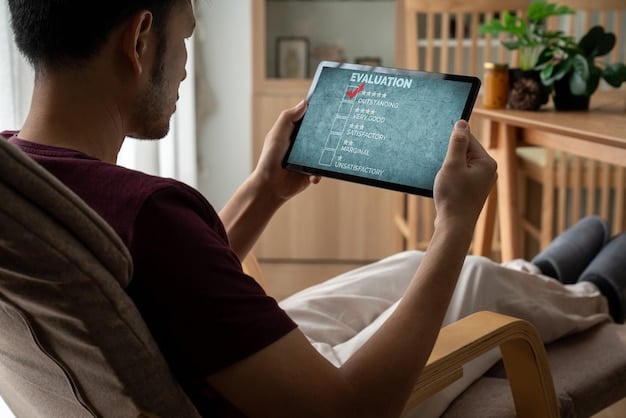Binge-Watching for Language Learning: 5 Series to Boost Skills

Engaging in binge-watching for language learning offers a highly effective and enjoyable method for improving linguistic skills, leveraging authentic dialogue and cultural context to enhance comprehension, vocabulary, and pronunciation.
In our increasingly interconnected world, mastering a new language opens doors to cultural understanding, career opportunities, and personal growth. While traditional methods have their place, an innovative and highly engaging approach has gained significant traction: binge-watching for language learning. This immersive strategy leverages the power of captivating narratives and authentic dialogue to transform passive viewing into an active linguistic workout. By immersing yourself in a language through captivating storytelling, you can naturally acquire vocabulary, refine pronunciation, and deepen your understanding of cultural nuances, making the often challenging journey of language acquisition both enjoyable and highly effective. This method offers a dynamic complement to textbook learning, bridging the gap between theoretical knowledge and practical application, all while enjoying some of the best entertainment available.
The Power of Binge-Watching for Language Acquisition
The concept of binge-watching for language learning is more than just a casual pastime; it’s a strategic and immersive approach that leverages our natural inclination towards storytelling. When we engage with a series for extended periods, we create a consistent and rich linguistic environment that simulates real-world exposure. This sustained immersion helps in recognizing speech patterns, understanding common idioms, and even picking up on subtle intonations that are often missed in more structured learning environments.
Unlike conventional study methods, which can sometimes feel rigid or abstract, watching engaging series provides context. Characters’ emotions, background scenes, and plot developments all contribute to a holistic understanding of the dialogue, making the learning process intuitive. This contextual learning is crucial for vocabulary retention, as words and phrases are naturally associated with specific situations, enhancing memory recall. Moreover, the repetitive exposure to certain phrases and sentence structures, inherent in any long-form narrative, reinforces passive recall and active usage.
Why Series Excel Over Movies for Language Learning
While movies offer a quick linguistic boost, series provide prolonged exposure to a consistent cast, setting, and narrative arc, which is highly beneficial for language acquisition. The continuity allows learners to grow accustomed to particular accents and speaking styles, building familiarity and confidence over time. This consistency minimizes the cognitive load associated with constantly adapting to new voices and settings, allowing the learner to focus more intently on the language itself.
- Character Familiarity: You get to know the characters and their unique speech patterns, making their dialogue easier to understand over time. This familiarity reduces the anxiety often associated with unfamiliar voices.
- Repetitive Vocabulary: Series often reuse specific vocabulary and phrases relevant to their plotlines, aiding in their memorization and natural integration into your lexicon.
- Natural Progression: As a series progresses, so does your understanding, creating a sense of achievement and encouraging continued learning. This progressive immersion makes the language feel less daunting and more accessible.
- Cultural Immersion: Many series offer deep dives into the culture of the language being learned, providing invaluable insights beyond just linguistics. This cultural context enriches the learning experience significantly.
The episodic nature of series also allows for manageable learning chunks. You can watch an episode, pause to review new vocabulary, and then return, making the process less overwhelming than a two-hour movie. This segmented approach enables a more focused and intentional learning experience, allowing learners to process information at their own pace.
Choosing the Right Series: Criteria for Effective Learning
Selecting the appropriate series is paramount for maximizing its effectiveness as a language learning tool. It’s not just about what’s popular; it’s about what genuinely supports your linguistic goals. The key is to find shows that strike a balance between entertainment and educational value, ensuring that you remain engaged while simultaneously absorbing new linguistic elements.
Consider your current language proficiency level. Beginners might benefit more from shows with clearer diction and simpler narratives, possibly even those designed for younger audiences. Intermediate learners can challenge themselves with more complex plots and faster dialogue, while advanced learners can delve into nuanced dramas or comedies that rely heavily on wordplay.
- Clear Dialogue: Opt for shows where characters speak relatively clearly and not too fast. Avoid overly mumbled conversations or heavy accents initially, as these can be demotivating.
- Genre Appeal: Choose genres you genuinely enjoy. If you love crime dramas, pick one. If comedy is your forte, lean into that. Your interest will sustain your motivation.
- Cultural Relevance: Series that reflect contemporary life and common scenarios can be more useful for acquiring practical, everyday language.
- Availability of Subtitles: Ensure the series offers subtitles in both your native language and the target language, as this is crucial for effective learning. Being able to toggle between them provides invaluable support.
The pacing of the series also plays a significant role. Fast-paced thrillers might be exciting, but the rapid dialogue can be hard to follow for a learner. Sometimes, a slower, more character-driven drama allows more processing time. Ultimately, the right series feels like an enjoyable challenge, not an insurmountable linguistic hurdle.

Optimizing Your Binge-Watching Strategy
Simply watching a series isn’t enough; to truly harness the power of binge-watching for language learning, you need a strategic approach. It’s about turning passive entertainment into an active learning session, making every minute count towards your linguistic progress. This involves more than just hitting play; it requires intentional engagement with the material.
Start by watching with subtitles in your native language to grasp the plot and main ideas. This foundational understanding prevents frustration and allows you to enjoy the narrative without the pressure of decoding every word. Once you’re comfortable with the story, rewatch scenes or even entire episodes with subtitles in the target language. This helps connect the spoken word with its written form, reinforcing vocabulary and grammatical structures. For advanced learners, try watching without any subtitles to truly test comprehension. This “cold-turkey” method, though challenging, significantly boosts listening skills.
Active Engagement Techniques:
- Pause and Repeat: Don’t hesitate to pause and repeat lines that are difficult to understand. Mimicking pronunciation and intonation is an excellent way to improve your speaking skills.
- Vocabulary Journal: Keep a notebook or digital document handy. Jot down new words, phrases, and expressions that pique your interest. Look them up later and try to use them in daily conversations or writing.
- Shadowing: Speaking along with the characters, imitating their speed, rhythm, and intonation, is an incredibly effective technique for improving fluency and naturalness.
- Contextual Guessing: Before looking up a word, try to guess its meaning from the surrounding dialogue and the context of the scene. This sharpens your inferential skills.
Remember that consistency trumps intensity. Even if you can only dedicate 30 minutes a day, regular exposure is far more beneficial than sporadic, long sessions. Make it a habit, integrate it into your routine, and view it as a rewarding extension of your language journey. The goal is to make learning feel effortless and enjoyable, rather than a chore.
Top 5 Series for Binge-Watching Your Way to Fluency
Here are five highly recommended series perfect for binge-watching for language learning, chosen for their engaging plots, clear dialogue, and broad appeal, catering to different learning styles and preferences. Each offers unique advantages for language acquisition, from cultural immersion to conversational practice. These selections are globally recognized, ensuring accessibility and a rich source of authentic language.
1. Friends (English – US)
Why it’s great for language learning: “Friends” is arguably one of the most beloved sitcoms worldwide, making it an excellent choice for English language learners, especially those focusing on American English. The clear, everyday dialogue among the core group of six friends makes it easy to follow. Its situational comedy often relies on relatable scenarios, providing context for common phrases and idioms. The recurring jokes and character quirks also help reinforce vocabulary and expressions through repetition. It’s perfect for understanding casual conversation and social nuances.
The humor in “Friends” is often universal, yet culturally specific, giving learners insight into American pop culture and social dynamics. Its relatively slow pace compared to some action-packed dramas allows ample time to process dialogue. Each episode is a self-contained story, which is less overwhelming for new learners. The familiar setting of apartments and coffee shops provides a comfortable backdrop for consistent listening practice, making it easier to track character interactions and plot lines.
2. Money Heist (La Casa de Papel – Spanish – Spain)
Why it’s great for language learning: If you’re looking to learn Spanish, “Money Heist” offers an exhilarating and immersive experience. While the dialogue can be fast-paced, the captivating plot keeps you hooked, encouraging continuous viewing. The distinct Spanish accents and varied vocabulary, ranging from formal negotiations to intense emotional outbursts, expose learners to a rich spectrum of the language. It’s particularly good for understanding different registers of speech and colloquialisms common in Spain. The high-stakes narrative ensures that every line feels impactful and contributes to your understanding.
The series also delves into complex character motivations and intricate planning, requiring careful listening to follow intellectual conversations. Subtitles are easily accessible in both Spanish and English, allowing learners to toggle for clarity. The dramatic tension often slows down dialogue during critical moments, providing windows for comprehension. Moreover, “Money Heist” has garnered global acclaim, making it easy to find discussion forums and fan content in Spanish, further enhancing the learning experience through active engagement with native speakers.

3. Dark (German – Germany)
Why it’s great for language learning: “Dark” an intricate German science fiction thriller, is an excellent choice for advanced German learners ready for a challenge. The dialogue is deep, philosophical, and often complex, but spoken with distinct Hochdeutsch (High German) accents, making it clear despite its intellectual density. Its non-linear storyline demands careful attention, which incidentally forces the learner to engage more deeply with the language to piece together the narrative. This show is superb for expanding advanced vocabulary, especially terms related to philosophy, science, and human emotions.
The show’s compelling mystery keeps viewers invested, encouraging them to push through any linguistic hurdles. Characters often engage in lengthy, thoughtful conversations, providing extended opportunities for listening comprehension. “Dark” also offers a window into German culture and small-town life, adding a layer of cultural immersion. While challenging, the reward of understanding its complex plot in its original language is immense, solidifying advanced comprehension skills and appreciation for nuanced German expressions. The intricate plot ensures active listening and critical thinking.
4. Call My Agent! (Dix pour cent – French – France)
Why it’s great for language learning: For those on a journey to master French, “Call My Agent!” is a delightful and highly effective option. This comedy series offers a charming glimpse into the fast-paced world of Parisian talent agents. The dialogue is authentic, witty, and often rapid, exposing learners to natural conversational French and common idioms used in everyday life. The characters’ clear articulation, even when speaking quickly, makes it manageable for intermediate learners to follow. It’s fantastic for picking up on contemporary French expressions, humor, and cultural references, particularly those related to the arts and entertainment industry.
The series is rich with relatable human interactions, from professional dilemmas to personal relationships, providing context for a wide range of vocabulary. The humor is often situational or relies on quick repartee, a great way to improve listening speed and understanding of social cues. Subtitles are readily available in both French and English, aiding comprehension. Moreover, the show’s light-hearted tone and episodic nature make it an enjoyable and low-pressure learning experience, fostering a positive association with the French language and culture. The varied professional and personal settings keep the vocabulary diverse.
5. Kingdom (Korean – South Korea)
Why it’s great for language learning: “Kingdom,” a thrilling South Korean historical zombie drama, is an exceptional resource for learning Korean. Set in the Joseon Dynasty, it offers diverse linguistic exposure, including both formal historical Korean (when royalty and nobles speak) and more common, everyday dialogue among the general populace. This duality helps learners distinguish between different speech levels, a crucial aspect of Korean language proficiency. The suspenseful plot and stunning cinematography ensure that learners remain engrossed, even when facing challenging vocabulary.
The clear pronunciation of the actors, even in intense scenes, is a huge plus for learners. The series is packed with action and emotional moments, which often provide visual cues to aid understanding when words are unfamiliar. “Kingdom” also offers profound insights into Korean history, social structure, and traditional customs, enriching the cultural understanding alongside language acquisition. For those interested in a blend of historical depth and thrilling narrative, this series provides a formidable yet rewarding opportunity to deepen their Korean language skills and cultural appreciation. Its unique setting provides a specialized vocabulary not often found in contemporary dramas.
Maximizing Retention and Enjoyment
The ultimate goal of using binge-watching for language learning is to make the process both highly effective and genuinely enjoyable. If it feels like a chore, you’re less likely to stick with it. Therefore, finding ways to maximize both retention and pleasure is key to sustained success. This involves integrating the language into your routine in a way that feels natural and motivating, not forced.
Creating a Conducive Learning Environment
Set aside dedicated time for your language learning sessions, just as you would for any other important activity. This consistency helps build a habit. Eliminate distractions by turning off notifications and focusing solely on the series. Consider watching in a quiet space where you can fully immerse yourself without external interruptions. Using over-ear headphones can also enhance clarity, allowing you to catch subtle pronunciations and intonations.
Don’t be afraid to rewatch episodes or even specific scenes multiple times. Each rewatch allows you to focus on different linguistic elements—first, the overall plot, then specific vocabulary, and finally, pronunciation or grammar. This layered approach deepens your understanding and retention. Moreover, try to engage with the show’s community online, perhaps by reading fan theories or discussions in the target language. This extends your language practice beyond passive viewing to active reading and even writing, as you might contribute to discussions.
- Balance Subtitles: Start with native language subtitles, then switch to target language, eventually aiming for no subtitles. This gradual removal of scaffolding strengthens listening comprehension.
- Take Breaks: Avoid burnout. Short, frequent sessions are often more effective than infrequent, marathon sessions. Your brain needs time to process and consolidate new information.
- Connect with Others: Discuss the series with fellow language learners or native speakers. This not only enhances your speaking skills but also builds a sense of community around your learning journey.
- Beyond the Screen: Seek out other media related to the series, such as interviews with the cast, behind-the-scenes footage, or even fan-made content. This expands your exposure to authentic language within a familiar context.
Remember, language learning is a marathon, not a sprint. Celebrate small victories, enjoy the process, and let the captivating narratives guide you toward fluency. The most effective learning happens when you are genuinely engaged and having fun, and binge-watching offers an unparalleled opportunity to achieve just that, making it a powerful tool in your linguistic arsenal.
| Key Aspect | Brief Description |
|---|---|
| 🎬 Engagement | Binge-watching keeps motivation high through compelling storytelling. |
| 🧠 Immersion | Provides consistent exposure to authentic language and cultural context. |
| 🗣️ Skills Boost | Enhances listening, vocabulary, pronunciation, and colloquial understanding. |
| 🔄 Optimized Strategy | Use dual-subtitles, pause-and-repeat, and shadowing for best results. |
Frequently Asked Questions
▼
For absolute beginners, binge-watching can be highly effective when combined with other fundamental learning methods. It offers crucial exposure to authentic pronunciation, intonation, and common conversational patterns that textbooks alone cannot provide. Start with native language subtitles to understand the plot, then transition to target language subtitles to connect spoken words with their written forms. Focusing on shows with clear dialogue and simpler narratives is key for initial success.
▼
Ideally, use a progressive approach. Begin with subtitles in your native language to grasp contextual meaning and plot without frustration. Once comfortable with the story, switch to subtitles in the target language. This helps link sounds to spellings and builds vocabulary. For advanced learners, attempt watching without any subtitles to challenge listening comprehension, using target language subtitles only when absolutely necessary to clarify specific phrases or words.
▼
Active learning involves more than just observation. Pause the show frequently to look up unfamiliar words and phrases, repeat dialogues out loud to practice pronunciation (shadowing), and take notes on new vocabulary or grammatical structures. Try to mimic character intonations and emotions. Discussing the show with others in the target language, or even writing short summaries, further solidifies learning. Make it a conscious effort, not just background noise.
▼
It’s completely normal not to understand every single word, especially when you’re starting out. Focus on grasping the overall meaning, the gist of the conversation, and key plot points. Trying to catch every word can lead to frustration. Over time, as your listening skills improve and your vocabulary expands, you’ll find yourself understanding more and more. Patience and consistent exposure are far more important than achieving 100% comprehension from the outset.
▼
Consistency is more crucial than intensity. Aim for regular, even short, sessions rather than infrequent, long ones that might lead to burnout. Watching an episode or two a few times a week is often more beneficial than a full-day marathon once a month. Integrate it into your routine, making it a sustainable and enjoyable part of your language learning journey. The goal is consistent exposure, allowing natural acquisition over time.
Conclusion
The journey of language acquisition is diverse and deeply personal, yet the method of binge-watching for language learning stands out as a remarkably effective and enjoyable pathway. It transcends the traditional confines of classrooms and textbooks, offering an authentic, immersive, and highly motivating experience. By strategically engaging with captivating narratives, learners not only expand their vocabulary and refine their pronunciation but also gain invaluable insights into cultural nuances and everyday communication. Whether you delve into the witty banter of “Friends,” the intense drama of “Money Heist,” or the intricate mysteries of “Dark,” each series offers a unique linguistic landscape waiting to be explored. This approach proves that learning can be an entertaining adventure, transforming screen time into a powerful tool for global connection and personal growth, making fluency an achievable and enjoyable reality for dedicated learners.





